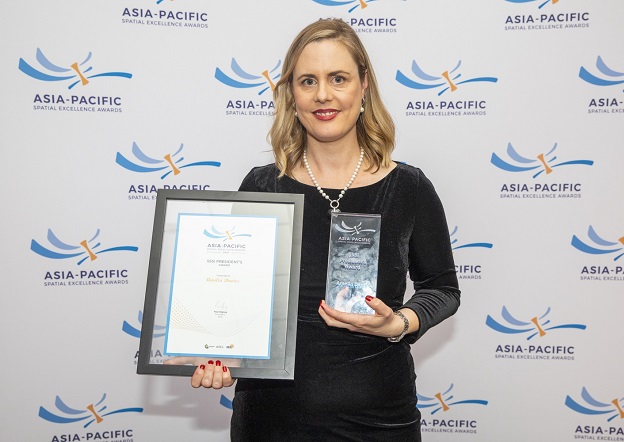
Amelia Davies is the recipient of the SSSI President’s Award in the 2021 Asia-Pacific Spatial Excellence Awards. Image courtesy Locate22.
Amelia Davies is a champion of change with a passion for unlocking value from data.
Amelia Davies is widely considered one of the most respected leaders within the Australian spatial sector, both through her ‘day job’ at the Australian Bureau of Statistics (ABS) and in her role as Chair of the Space, Spatial and Surveying Diversity Leadership Network (SSS-DLN). She is the recipient of the SSSI President’s Award in the 2021 Asia-Pacific Spatial Excellence Awards.
What was your journey into this industry?
I very much fell into the spatial industry; I come from a public policy background originally. Looking for my next challenge, I jumped at the chance to join the leadership team at Land Use Victoria, looking after the state’s foundational spatial data, Vicmap. This is where I fell in love with spatial data and technology and the amazingly committed and talented people who choose this as their career.
Tell us about your current role — what kind of work do you do?
I am Director of Location Capability at the ABS, where one of my key roles is to deliver an enterprise geospatial roadmap that charts a course for ABS geo-enriched data for the next five years. A big part of my role is storytelling — helping the ‘spatially curious’ figure out how to unlock more value from their data through location.
What makes you so passionate about this industry?
I love how our work unlocks value from data to help solve some of our most pressing challenges. We are living in a time of ‘digital natives,’ where consumers are expecting technology experiences to be frictionless and akin to what they can get on their mobile. Our industry is at the forefront of the revolution in our ability to bring meaning to ‘data about place,’ seamlessly from any device.
Tell us about the SSS-DLN.
The SSS-DLN brings together leadership from business, government, research and education to provide visible advocacy for diversity, equity and inclusion (DE&I) within the space, spatial and surveying professions. We aim to dramatically improve the state of diversity and inclusion in our sectors, and we focus on five areas to help us towards this vision: creating an active network of change makers; monitoring and reporting; leading by example; sharing impact stories that educate and empower; and recognising and rewarding DE&I champions.
What can individuals do on a day-to-day basis to support the cause?
The single biggest thing we can do as individuals is to respectfully call out inequitable practices, language and behaviours that may exclude others when we see them. If you’re in a position of leadership, actively seek out diverse views when making decisions or collaborating with team members. The recent Inclusion@Work study reports that employees who feel included are five times more likely to innovate on the job, 8.5 times less likely to leave the workplace, and six times more likely to work effectively and provide excellent customer service. I can’t think of a single business that wouldn’t welcome that sort of productivity gain.
What are some of the industry’s other challenges?
Shoring up our talent pipeline continues to be a major challenge, where skills shortages and low visibility with future employees are putting the competitive advantage and sustainability of our profession at risk. But it’s not enough to just focus on graduates — we also need to focus on reskilling, skills transfer and knowledge capture from more experienced colleagues.
And what are some of the industry’s strengths?
I’d like to think that governments all over Australia have contributed to our industry’s strength through provision of high-quality fundamental national geospatial data infrastructure. The last couple of years have really cemented the value of location-based data in decision-making, and this infrastructure has underpinned our ability to provide timely, decision-ready advice.
What was your reaction to receiving the President’s Award?
I was completely shocked and surprised and had to do a double-take to make sure I wasn’t hearing things! It was so humbling to have my work with SSS-DLN, making our industry more diverse and inclusive for everyone, recognised in front of my peers and with my fellow SSS-DLN conveners in the room.
What’s on your wish list for the next 12 months?
I really hope we continue the momentum of Locate 2022 in Canberra and have our industry celebrated as a leading example of the positive impact of diversity, inclusion, equity and belonging in the STEM community. I hope we have the collective courage to go deeper than just ticking the box.
Do you have any overall message for Position readers?
Please consider joining a growing network of leaders and change makers and become a member of the SSS-DLN. Membership is free and we welcome all industry professionals who would like to advocate, support or learn more about diversity and inclusion within the sector.
Stay up to date by getting stories like this delivered to your inbox.
Sign up to receive our free weekly Spatial Source newsletter.







